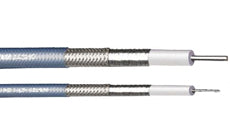
Product Details
Center Conductor: Solid or Stranded silver plated copper
Dielectric: Expanded PTFE tape
Inner Shield: Spiral strip of silver plated copper
Outer Braid: Round silver plated copper
Jacket: Blue translucent FEP
Operating temperature: -55 +200° C
Velocity of Propagation: 81%-85%
Impedance: 50 Ohms
Shielding Effectiveness: <-110 db
| Center conductor diameter (in.) |
Dielectric diameter (in.) |
Bend radius (in.) |
Part Number | Action |
| .0403 solid | .111 | .8 | LLS160-40GHZ | Request A Quote |
| .057 stranded | .147 | 1.0 | LLS195STR | Request A Quote |
| .051 solid | .145 | 1.0 | LLS195 | Request A Quote |
| .064 solid | .174 | 1.1 | LLS220 | Request A Quote |
| .089 solid | .241 | 1.45 | LLS290 | Request A Quote |
| Attenuation (dB/100ft) @ | LLS160-40GHZ | LLS195STR | LLS195 | LLS220 | LLS290 |
| 400 MHz | 6.3 | 5.0 | 4.7 | 3.9 | 2.7 |
| 1 GHz | 10.0 | 7.9 | 7.5 | 6.2 | 4.3 |
| 3 GHz | 17.7 | 14.1 | 13.2 | 10.9 | 7.7 |
| 5 GHz | 23.1 | 18.5 | 17.2 | 14.3 | 10.1 |
| 10 GMHz | 33.4 | 26.9 | 24.9 | 20.7 | 14.8 |
| 18 GHz | 46.0 | 37.3 | 34.2 | 28.5 | 20.6 |
| 40 GHz | 71.8 | - | - | - | - |
Designed for Low Attenuation: The inner silver plated flat strip shield coupled with higher velocity expanded PTFE tape dielectrics yield lower attenuation levels over operating frequencies.
LLS cables are smaller and lighter weight than comparable LL flat strip braid constructions.
Return loss improved by minimizing inherent spikes from the strip braid and interlayer
Shielding Effectiveness levels have been measured at <-110 db
Special connectors have been designed and are readily available.
Attenuation Calculation and K Factors: Although typical and maximum attenuation values are given for discrete frequencies, typical attenuation values may be calculated by using K1 and K2 factors for each construction. The K1 factor is calculated by taking into consideration the type, strand factor, and diameter of the center conductor, and the impedance of the cable. The K2 factor is calculated by taking into consideration the velocity of propagation and the dissipation factor of the dielectric.
Formula for Calculating Attenuation using K Factors: Attenuation (dB/100 ft) at any frequency (MHz) = (K1 x root of frequency + (K2 x frequency)
| - | LLS160-40GHz | LLS195STR | LLS195 | LLS220 | LLS290 |
| K1 | .309 | .243 | .231 | .19 | .131 |
| K2 | .0002500 | .0002600 | .0001785 | .000168 | .0001674 |
